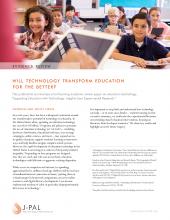Will Technology Transform Education for the Better?
In recent years, there has been widespread excitement around the transformative potential of technology in education. The hype around education technology is rapidly outpacing evaluation of ed tech programs. How do we ensure that these innovative tools are actually helping our students learn? And how do we know the massive investment in education technology is well-spent?
J-PAL’s Education Technology Evidence Review aims to help education leaders understand which uses of education technology go beyond the hype and truly improve student learning. The Evidence Review summarizes key takeaways from 126 rigorous studies of technology-based education interventions, focusing on literature from developed countries.
The Evidence Review is designed to support the work of educators and education administrators, ed tech companies, policymakers, and funders and highlight areas for future inquiry in the field.
Key results from the Evidence Review are as follows:
- Initiatives that expand access to computers and internet alone generally do not improve kindergarten to 12th grade students’ grades and test scores, but do increase computer usage and improve computer proficiency.
- Educational software designed to help students develop particular skills at their own rate of progress have shown enormous promise in improving learning outcomes, particularly in math.
- Technology-based nudges that encourage specific, one-time actions—such as text message reminders to complete college course registrations—can have meaningful, if modest, impacts on a variety of education-related outcomes, often at low costs.
- Combining online and in-person instruction can work as well as traditional in-person only classes, which suggests blended learning may be a cost-effective approach for delivering instruction. Students in in-person-only courses, however, tend to perform better than students in online-only courses .
